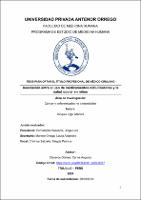Asociación entre el uso de medicamentos nebulizadores y la salud ocular en niños
Resumen
Objetivo: Determinar si el uso de medicamentos nebulizadores es un factor
asociado a patología ocular en niños de la clínica Mioftalmocenter.
Material y Métodos: Se realizó un estudio de tipo observacional, de diseño
casos y controles en relación 1:2 no pareado en base a 111 pacientes entre los
2 y 18 años del consultorio externo de oftalmología de la clínica Mioftalmocenter.
Fueron distribuidos en dos grupos: 37 pacientes con patología ocular y 74
pacientes sanos; se evaluó la presencia del uso de nebulización previa y el
análisis estadístico fue realizado con frecuencias absolutas y porcentajes
distribuidos en tablas y figuras, mientras que para la asociación entre variables
se usó STATA versión 17.0, con uso de prueba bivariada según normalidad de la
variable y regresión logística con determinación de Odds Ratio para el análisis
crudo y ajustado, bajo un error alfa del 5%.
Resultados: La edad promedio de los pacientes fue de 10 +/- 4 años, con un
similar porcentaje de ambos sexos. Se encontró una frecuencia de antecedente
bronquial en el 59% de los casos, donde la mayoría presentaba asma. El 43%
de los pacientes que usaron nebulización previa presentó síndrome de ojo seco,
el 19% conjuntivitis infecciosa, el 14% queratitis infecciosa, otro 14% presentó
hipertensión ocular, 5% catarata y otro 5%, glaucoma. No se observaron
diferencias significativas en las variables sexo y edad entre ambos grupos de
estudio (p>0,05). Se encontró asociación significativa entre patología ocular y
presencia de antecedente bronquial (p=0,003), y uso de corticoide nebulizado
(p=0,008). El uso de nebulización previa no llegó al rango de significancia, sin
embargo, se encontró un odds ratio ajustado significativo entre antecedente
bronquial y patología ocular: 6,47(IC 95%: 1,63-25,70; p=0,008),
Conclusiones: No existe una asociación significativa entre el uso de
medicamentos nebulizadores y la presencia de patología ocular en niños Objective: Determine if the use of nebulizer medications is a factor associated
with ocular pathology in children at the Mioftalmocenter clinic.
Material and Methods: An observational study, with a case-control design in a
1:2 unpaired ratio, was carried out based on 111 patients between 2 and 18 years
old from the outpatient ophthalmology clinic of the Mioftalmocenter clinic. They
were distributed into two groups: 37 patients with ocular pathology and 74 healthy
patients; The presence of the use of prior nebulization was evaluated and the
statistical analysis was carried out with absolute frequencies and percentages
distributed in tables and figures, while STATA version 17.0 was used for the
association between variables, with the use of a bivariate test according to
normality of the variable and logistic regression with determination of Odds Ratio
for the crude and adjusted analysis, under an alpha error of 5%.
Results: The average age of the patients was 10 +/- 4 years, with a similar
percentage of both sexes. A frequency of bronchial history was found in 59% of
the cases, where the majority had asthma. 43% of the patients who used prior
nebulization presented dry eye syndrome, 19% had infectious conjunctivitis, 14%
had infectious keratitis, another 14% had ocular hypertension, 5% had cataracts,
and another 5% had glaucoma. No significant differences were observed in the
sex and age variables between both study groups (p>0.05). A significant
association was found between ocular pathology and the presence of a bronchial
history (p=0.003), and use of nebulized corticosteroid (p=0.008). The use of prior
nebulization did not reach the range of significance; however, a significant
adjusted odds ratio was found between bronchial history and ocular pathology:
6.47 (95% CI: 1.63-25.70; p=0.008).
Conclusions: There is no significant association between the use of nebulizer
medications and the presence of ocular pathology in children
Palabras clave
Colecciones
- Medicina Humana [2969]


